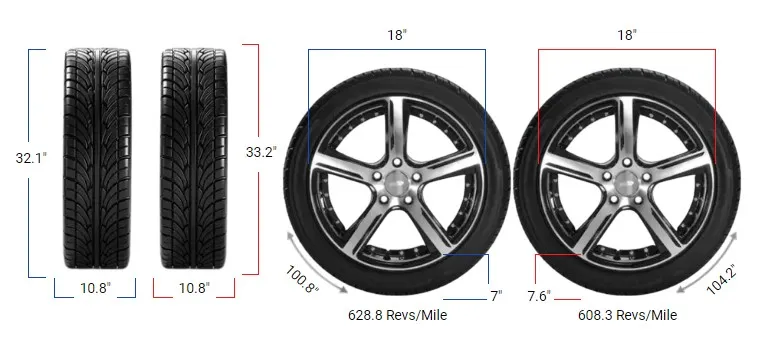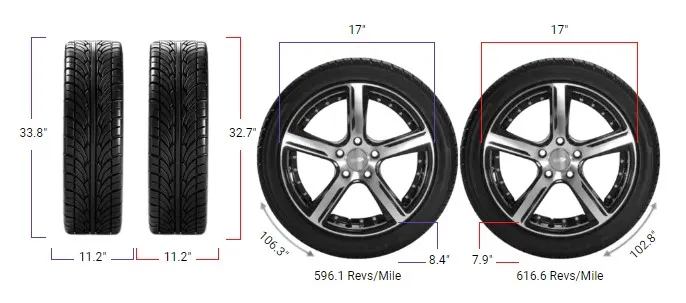195 vs 205 Tires

The most noticeable difference between 195 and 205 tires is their width. The 205 tires is about 10 mm wider than the 195 tires. The 195 tire measures 195 millimeters across the tread, while the 205 tire is 205 millimeters wide. This additional 10 millimeters impacts a range of factors, from handling to fuel economy.
A wider tire, such as the 205, has a larger contact patch, meaning more rubber meets the road. This can result in improved traction and stability, particularly during high-speed driving or when taking sharp turns.
On the other hand, the 195 tire offers a narrower profile, which often leads to less rolling resistance. This characteristic can enhance fuel efficiency and make the vehicle feel more agile, particularly in urban settings where frequent maneuvers are needed.

On-Road Impact
The choice between 195 and 205 tires can greatly influence your on-road driving experience:
- Handling and Stability: The wider 205 tire provides a greater lateral grip, which can improve stability, especially during cornering or high-speed driving. This can be particularly beneficial for those who prioritize handling performance, such as drivers who frequently drive on winding roads or highways.
- Fuel Efficiency: On the flip side, the narrower 195 tire tends to be more fuel-efficient due to reduced rolling resistance. The smaller contact patch means less friction with the road, which translates to less effort needed by the engine to maintain speed, making 195 tires an excellent choice for those focused on maximizing fuel economy.
- Ride Comfort: The 205 tire can offer a slightly smoother ride due to the larger contact patch, which helps absorb road imperfections better. However, it may also produce more road noise, especially on rough pavement. Meanwhile, 195 tires may provide a firmer ride, but they tend to generate less noise, making them ideal for long highway drives.

Off-Road Impact
For those who occasionally venture off-road, the difference between 195 and 205 tires can also affect performance:
- Traction on Loose Surfaces: The 205 tire offers a wider footprint, which can provide better traction on loose surfaces like gravel or sand. This makes it more suitable for light off-roading, as the larger contact patch helps distribute the vehicle’s weight more evenly, reducing the likelihood of getting stuck.
- Maneuverability: On the other hand, the 195 tire may be advantageous in off-road situations where precision is required. Its narrower profile allows for better maneuverability through tight spaces or rocky terrain, providing more control in challenging conditions.
Speedometer Differences
Switching from 195 to 205 tires can affect your vehicle’s speedometer and odometer accuracy. The overall diameter of the tire may change slightly depending on the specific aspect ratio, which influences how the speedometer calculates speed.
If the overall diameter of the 205 tire is larger, the speedometer may read a lower speed than your actual speed, and the odometer may underreport the distance traveled.
To maintain accurate speed and distance readings, it may be necessary to recalibrate the speedometer after changing tire sizes, especially if the new size has a significantly different overall diameter.

Benefits of 205 Tires:
- Improved Traction and Handling: The wider 205 tire provides better traction and stability, particularly during cornering or high-speed driving.
- Enhanced Comfort: The larger contact patch helps in absorbing road imperfections, offering a smoother and more comfortable ride.
- Aggressive Appearance: Many drivers prefer the look of a wider tire, which gives the vehicle a more assertive and sporty stance.
Drawbacks of 205 Tires:
- Reduced Fuel Efficiency: The increased width of 205 tires results in greater rolling resistance, which can lead to reduced fuel efficiency, especially in city driving conditions.
- Potential Clearance Issues: Depending on your vehicle, the wider 205 tire might require more space, which could lead to clearance issues, particularly when turning or driving over bumps.
Benefits of Staying with 195 Tires:
- Better Fuel Economy: The 195 tire offers less rolling resistance, translating to better fuel efficiency, making it an ideal choice for those looking to save on fuel costs.
- Lower Noise Levels: 195 tires tend to generate less road noise, providing a quieter and more relaxed driving experience, especially on long trips.
- Improved Maneuverability: The narrower profile of 195 tires makes them easier to handle, particularly in urban environments where tight turns and quick maneuvers are common.
Drawbacks of 195 Tires:
- Less Traction: The smaller contact area of the 195 tire can result in reduced traction, particularly on wet or slippery roads, which may affect overall stability.
- Less Sporty Look: For those who value aesthetics, 195 tires may not provide the same aggressive appearance as 205 tires.

Difference Between 195 and 205 Tires
The main difference between 195 and 205 tires is their width. 205 tires are 10mm wider than 195 tires, impacting handling, stability, and vehicle performance. A wider tire generally provides better grip, but may affect fuel efficiency.
Can I Use 195 Tires Instead of 205?
Yes, you can use 195 tires instead of 205 tires, provided the ideal rim width range for both overlaps. Also, make sure the aspect ratio and rim diameter match, and that the overall diameter difference is within 3%.
Can I Use 205 Tires Instead of 195?
Yes, it is possible to use 205 tires instead of 195 tires. The ideal rim width range must overlap to ensure safety and performance. Additionally, the aspect ratio and rim diameter should match, and the overall diameter difference should stay within 3%.
Can You Put 195 Tires on 205 Rims?
Yes, you can put 195 tires on rims designed for 205 tires if the ideal rim width range overlaps. This ensures compatibility and maintains performance, but keep in mind that narrower tires may slightly impact handling.
Can You Put 205 Tires on 195 Rims?
Yes, you can put 205 tires on rims designed for 195 tires if the ideal rim width range overlaps. However, the wider tires may affect handling and wear on narrower rims, so proper fitment should be ensured.
Our Observation
In our observation, the choice between 195 and 205 tires largely depends on your driving style and needs. If you prioritize fuel efficiency, maneuverability, and a quieter ride, 195 tires are likely the better option.
However, if you value enhanced traction, stability, and a sportier look, 205 tires might be the perfect fit. Regardless of the size you choose, it is essential to ensure that your vehicle’s rims are compatible with the new tires and that there is sufficient clearance in the wheel wells.



